Monocotyledons or in short monocots are a group of angiosperm plants having only one cotyledon or embryonic leaf in their seeds. Here we are going to briefly discuss about some examples of monocot.
There are more than 60000 species included in this group. Let’s see some very common examples of monocot-
- Orchids
- Sugarcane
- Lilies
- Palm trees
- Bananas
- Bamboo
- Tulips
- Iris
- Aloe vera
- Daffodils
- Snowdrops
- Coconut trees
- Pineapple
- Wheat
- Jowar
- Barley
- Maize
- Rice
- Onions
- Asparagus
Monocot plant examples
Let’s have a closer look at the examples of monocot-
Orchids
Orchids are the largest group of monocot species. All the species under the family Orchidaceae have only one cotyledon in their seeds. These flowering plants are able to adapt to all kinds of temperatures hence found in almost every habitat apart from glaciers. Moth Orchids, Dendrobium, Boat Orchids, Cattleya Orchids, all are very common examples of monocot.

Examples of monocot : Orchids from Pixabay.com
Sugarcane
More than 20000 species from the family Poaceae or true grasses are typical examples of monocot. Sugarcane is sugarcane or Saccharum officinarum is one of them. It has only a single cotyledon in a seed. In the agricultural aspect, it is an important grass species because 70% of the sugar content is produced from them.
Lilies
Just like orchids, lilies are also one of the most common monocot plant groups found. The tetramerous petals of the flower are the most important character which indicates it to be monocot. Most of species of lilies are native to temperate climates. Apart from true lilies, there are several other species known as lilies, like Dwarf dayLily, Knight Lily, etc are also common examples of monocot.
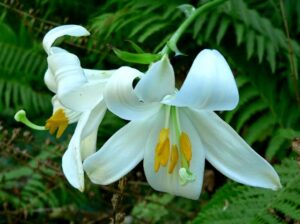
Lilies from Wikimedia Commons
Palm trees
Though most of the monocot plants are herbaceous, usually smaller as their secondary growth is limited. But being monocots, palm trees use their vascular bundle and lignin in such a way that they became the largest among all, just like dicots. The only visible thing which indicates the monocot’s character in palms is the structure of its leaves. It has long, ribbon-like leaves, with veins running parallel to each other. Some common monocot palm trees are Date palm, Areca palm, Trachycarpus fortunei, etc.
Bananas
The banana plant is also one of the common examples of monocot. It belongs to the family Musaceae closely related to the grass family Poaceae. Just like typical monocots it lacks secondary growth and has its leaves following the parallel pattern of the vein. After producing fruits the plant dies in a regular manner.

Bananas from Wikimedia Commons
Bamboo
Bamboos belong to the grass family Poaceae under the subfamily Bambusoideae. These evergreen columnar perennial plants are also one of the most common examples of monocot. Just like other monocot plants bamboos also lack secondary growth but are taller in size. Most of the bamboo species’ flowering occurs after 12-120 years of the growth period and produces seeds once in their lifetime.
Tulips
Tulips are also the most common herbaceous perennial monocot plants belonging to the family Liliaceae. The plant bears large colourful actinomorphic flowers. Tulips are typically bulbiferous means bear an underground storage bulb. There are about 75 different tulip species found and all are typical monocots in nature.

Tulips from Pixabay.com
Iris
Irises are perennial monocots belonging to the family Iridaceae. Some of the iris plants are bulbaceous means bear bulbs and have cylindrical basal leaves. Some of the irises are rhizomatous, which means that they grow rhizomes, and have sword-shaped leaves 3-10 in number. There are 260-300 species found under this genus and all are typical monocots in nature.
Aloe vera
Aloe vera is an evergreen perennial succulent monocot plant belonging to the family Asphodelaceae. In tropical and subtropical regions it grows mostly. The genus contains more than 500 species which are typically monocots. Its thick, fleshy, green leaves make aloe vera unique. It also forms arbuscular mycorrhiza which improves access to mineral nutrients from the soil.
Daffodils
Daffodils or Narcissus are a genus of spring flowering herbaceous plants, belonging to the family Amaryllidaceae, one of the most common examples of monocot. There are more than 50 species under this genus, all are typical monocots.

Daffodils from Wikimedia Commons
Snowdrops
Snowdrop is a herbaceous perennial monocot flowering plant belonging to the family Amaryllidaceae. About 20 species are present under the genus Galanthus. Galanthus nivalis is the most common species among all, mainly found in the European region. The white drooping flower with free perianth segments in two whorls between the two linear leaves completely justified the name snowdrop.
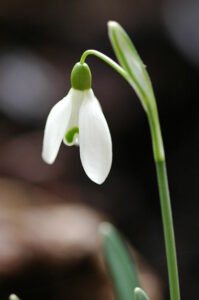
Snowdrop from Wikimedia Commons
Coconut trees
Coconut trees belong to the family Arecaceae or the palm family. Just like other palms, it is also a monocot plant lacking the secondary growth. Cocos nucifera is the only living species under the genus Cocos. It can produce fruit in six to ten years and continue up to15 to 20 years. It produces a special fruit called a drupe. It is a monoecious plant that bears both male and female flowers in an inflorescence.
Pineapple
Pineapple is a herbaceous tropical flowering monocot plant belonging to the family Bromeliaceae. It produces up to 200 flowers to bear fruit.
Wheat
Wheat is one of the most common examples of monocot, belonging to the family Poaceae means the grass family. More than 24 species under the genus Titricum are found, in which 95% of Titricum aestivum is produced worldwide. It bears 20-100 flowers in an inflorescence. The flowers later grow as spikelets in groups and produce grains.
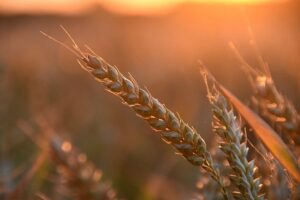
Wheat from Wikimedia Commons
Jowar
Jowar or Sorghum is also a very popular grain species belonging to the grass family Poaceae. About 30 species under the genus sorghum are found and all are monocots. The plant bears flower clusters with 800-3000 kernels and produces seeds.
Barley
Barley or Hordeum vulgare is a herbaceous monocot plant belonging to the grass family Poaceae. It is a self pollinated species and has 14 numbers of chromosomes. The barley grows mostly in temperate climates. It is one of the world’s first cultivated grains. The barley is mostly used as animal fodder. 30% of the barley grain is used in the fermentation process to produce beer and other beverages in several countries.
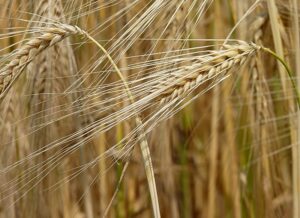
Barley from Wikimedia commons
Maize
Maize or corn is a herbaceous grain producing plant species belonging to the grass family Poaceae. There are three types of roots that arise from the maize- seminal roots, adventitious roots and brace or prop roots. It is a monoecious plant, both the sexes are present but partitioned by staminate (male flower) and pistillate (female flower). The male flower matures earlier than the female and after the maturation of the female flower a thread like structure forms through pistillate called silks. Pollination takes place when new moist silk catches pollen grains.
Rice
Rice or Oryza sativa is one of the most cultivated cereal producing species worldwide. It is known as the common rice or the Asian rice belonging to the grass family Poaceae, typically monocots. There are two different subspecies found. It is an annual grass, which dies regularly after producing grains. It contains long, flattened leaves and a fibrous root system. The inflorescence has spikelets in it.
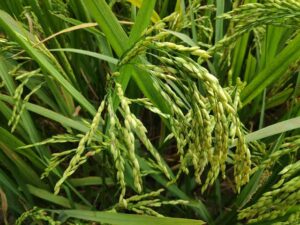
Rice plant from Wikimedia Commons
Onions
The onion plant is a herbaceous bulbaceous biennial monocot plant species belonging to the family Amaryllidaceae. Several onion species are found belonging to the genus Allium. The bulb onion or the Allium cepa is the most widely cultivated onion species. The onion plants are mostly cultivated in the temperate climate of the northern hemisphere. It is bulbaceous and means to bear true bulbs borne on rhizomes.
Asparagus
Asparagus or sparrow grass herbaceous perennial monocot plant species belongs to the family Asparagaceae. The species is closely related to the Allium species. The young shoots of the plant are commonly eaten.
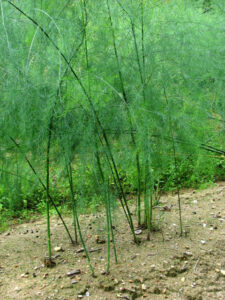
Examples of monocot: Asparagus from Wikimedia Commons
So these are some very common examples of monocot. All of the mentioned examples are mostly found in temperate climates. Most of the plants dies regularly after producing fruits means they has short lifespan usually.
In most of the monocot plants, the roots are not true roots, after germination of the plant the tap roots usually die and fibrous, widely spread adventitious roots grow from there.
In monocot plants the secondary growth is absent means not able to increase its diameter by producing bark. Most of the species are herbaceous, stems of the plant die every year and new stems grow from there.
In monocots, the flowers are typically trimerous and the embryo has only one cotyledon in the seed.
As a whole, we can say that monocot plants are angiosperm plants that have only one cotyledon in their seed. There are several different monocot plants found mostly are herbaceous. Some monocot plant species, mostly the palms, are the largest among all. Here we discuss several examples of monocot. Hope this article on monocot plants will be helpful to you.
Please click to learn more on Examples Of Dicot.
Also Read:
- Dna replication steps
- Fungi chromosome structure
- Do bacteria have cell walls
- Does yeast have mitochondria
- Do ribosomes make proteins
- Cells with multiple nucleus
- Does facilitated diffusion require energy
- Are bacteria prokaryotic or eukaryotic
- Incomplete flower example
- Why is dna replication semiconservative

Hello, I am Piyali Das, pursuing my Post Graduation in Zoology from Calcutta University. I am very passionate on Academic Article writing. My aim is to explain complex things in simple way through my writings for the readers.